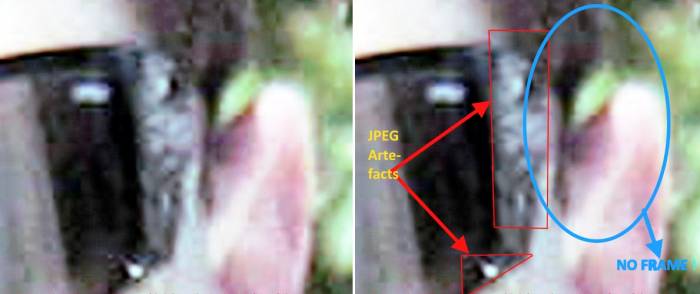Table of Contents
Other fakes in the last photo of Maddie
For the likelihood of this, we first have to do some technical and historic →reasonig about alterations of photos in general (extract from Wikipedia):
Photo manipulation is the application of image editing techniques to photographs in order to create an illusion or deception after the original photographing took place. A mere enhancement or correction is known as retouching. Before computers, photo manipulation was achieved by retouching with ink, paint, double-exposure, piecing photos or negatives together in the darkroom, or scratching Polaroids. Airbrushes were also used, whence the term “airbrushing” for manipulation. Darkroom manipulations are sometimes regarded as traditional art rather than job related skill. In the early days of photography, the use of technology was not as advanced and efficient as it is now. Results are similar to digital manipulation but they are harder to create. Photo manipulation is as old as photography itself, contrary to the idea of a photo having inherent →verisimilitude (Truth). Photo manipulation has been regularly used to deceive or persuade viewers, or for improved storytelling and self-expression. Often even subtle and discreet changes can have profound impacts on how we interpret or judge a photograph which is why learning when manipulation has occurred is important. As early as the American Civil War, photographs were published as engravings based on more than one negative.
The growing popularity of image manipulation has raised concern as to whether it allows for unrealistic images to be portrayed to the public. In her article “On Photography” (1977), Susan Sontag discusses the objectivity, or lack thereof, in photography, concluding that “photographs, which fiddle with the scale of the world, themselves get reduced, blown up, cropped, retouched, doctored and tricked out”. A practice widely used in the magazine industry, the use of photo manipulation on an already subjective photograph, creates a constructed reality for the individual and it can become difficult to differentiate fact from fiction. With the potential to alter body image, debate continues as to whether manipulated images, particularly those in magazines, contribute to self-esteem issues in both men and women.
→Photojournalism works within the same ethical approaches to objectivity that are applied by other journalists. What to shoot, how to frame and how to edit are constant considerations. Photographing news for an assignment is one of the most ethical problems photographers face. Photojournalists have a moral responsibility to decide what pictures to take, what picture to stage, and what pictures to show the public. Another major issue of photojournalism is photo manipulation – what degree is acceptable? Some pictures are simply manipulated for color enhancement, whereas others are manipulated to the extent where people are edited in or out of the picture. War photography has always been a genre of photojournalism that is frequently staged. Due to the bulkiness and types of cameras present during past wars in history, it was rare when a photograph could capture a spontaneous news event. Subjects were carefully composed and staged in order to capture better images. Another ethical issue is false or misleading captioning. The emergence of digital photography offers whole new realms of opportunity for the manipulation, reproduction, and transmission of images. It has inevitably complicated many of the ethical issues involved. Laws regarding photography can vary significantly from nation to nation. In the history of photojournalism there were some photographers who did not follow ethical principles and sought only to gain celebrity through taking spectacular shots. Many of them faced loss of credibility and were also fired from the newspapers.
Mike Meadows of the Los Angeles Times was covering a major wild fire sweeping southern California. His picture of a fireman cooling himself off with water in a pool ran not only in the Times but also nationally. Prior to submitting the photograph for a contest, the newspaper's editor contacted the fireman, who said he had been asked by the photographer to go to the pool and splash water on his head. The photographer responded “I may have been guilty of saying 'this would make a nice shot', but I did not directly ask him to do that”. What Meadows did not understand was that even a suggestion to a subject in a news situation is a form of interference—and thus out of place on the continuum of control. The picture was withdrawn from competition and the photographer left the paper. Edward Keating, a Pulitzer Prize winner from The New York Times, photographed a young boy pointing a toy gun outside a Middle Eastern grocery store, near a town where the FBI raided an alleged Al Qaeda cell. Other photographers at the scene claimed that Keating pointed with his own arm to show the boy which way to look and aim the gun. After the Columbia Journalism Review reported the incident, Keating was forced to leave the paper.
From the EXIF Data of the Last photo we know that it was taken originally on 3rd May 2007, was altered using Adobe Photoshop software on 24th May 2007, and handed out by the McCann's to AFP for press release as the last photo of Madeleine alive respectively with (lucky) family.
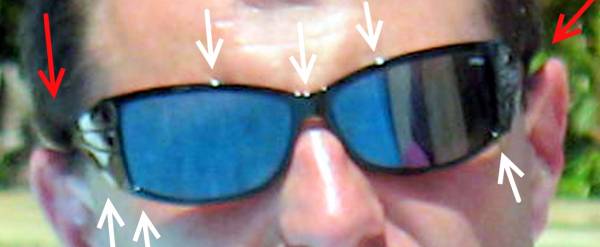
From the sunglasses with physically impossible false horizon, in addition also with no frames at the ears, we definitly know that the last Photo of Madeleine is a deliberate fake.
The faked sunglasses then also tells us something obvious about Gerry McCann's need to hide his eyes in the photo taken on the day of disapparence 3rd May 2007. From the principle fact of a fake we have now to doubt anything else in the photo too (And, besides this, we may doubt any testimony done by the McCann's, as this fact shows that Gerry and Kate obviously have no scruple to fake any evidence for the public.)
One of the main question here of course is, was Madeleine also put into the “Last Photo” by cut and paste?
So ethical and legal considerations about photo manipulation and/or just retouching depends of course on the intended use of a photo.
E.g. in fashion photography and advertising business, there are usually no large concerns regarding picture manipulation. It is indeed part of their business and modern professional Picture-Manipulating software like Adobe Photoshop are well designed tools to do exactly what is a nightmare for any professional working forensic expert: Manipulating and composing pictures together from a lot of unrelated sources to one seemingly authentic picture. In professional Advertising this may be any objects, peoples and backgrounds, lights and shadows and what ever else used as building blocks for the final product, e.g. a poster.
Another case is given of course in any documentary photography. In such a case, like in forensics or giving testimony/evidence and even in photojournalism manipulating pictures is ethical and mostly also forbidden by law. What is mostly not forbidden or unethical is to enhance e.g. the colours of a picture for more contrast such that it appears a little bit more nicely.
But Gerry did attestable much more. The fatal fact now is that photographic software widely used in the advertising industry may be also used to fabricate nearly perfect fakes and false evidence. A lot of picture manipulating things are done automatically by software, but overall it depends on the photographic education of the software user how well done the final product will be. The counterfeiter has to be aware of the lot of photographic and physical effects of optics to avoid defects in the final product.
Thus, if we like to expose a fake as a forensic expert, we always have to hope that the falsifier makes some mistakes in his work.
In the case at hand, we have already a prove of the fake done as Gerry McCann was not aware of the physical effect that mirrors never flip horizons. A failure which a lot of people are not aware of and thus don't see on a first view. The next failure is that he didn't complete the sunglasses' frame to the ears. A thing which could have been fixed easily by looking at the pixel details and just appending some black colour. But he forgot to do so.
From which we can conclude, that (1) on one hand he was not aware of some typical problems with altering photos, and (2) on the other hand but he was educated enough to use professional Adobe Photoshop software purposeful.
So let us look at some further details:
As we already can see at the sunglasses: Gerry's Photoshop obviously worked very well in not making big problems with cut and paste of picture parts, which is that there are no easily detectable margins between them. As this is one of the principal tasks of Photoshop and thus works practically perfect. Other problems but are shadows (which may be altered but needs some optical knowledge), colour-temperature (which is mostly altered automatically but sometimes must be fine-tuned by hand) and different resolutions (which also maybe fine-tuned). Did he make some more mistakes?
Analysing Shadows
Analysing shadows physically is a real tough task. This is due to the fact that shadows are a full 3D-problem while a photo always give us only a 2D-projection which lacks a lot of informations which must be reconstructed by other means. There was a reconstruction done in internet by →"Provo" which but is much to simple and cursory. It must be said, that for a forensic full reconstruction one has to construct a complete 3D-model of the situation and then using Ray-tracing software to calculate the theoretical shadows which then could be compared exactly with the shadows to be seen in the "Last Photo" of Madeleine provided by Gerry McCann. This but is a very much time consuming and thus costly task. But we will do it here without a complete but a roughly partial 3D-model for the main forensics.
Well, If an objects shadow falls on rectangular plain surfaces its easy to analyse. But usually shadows fall on very irregular surfaces with arbitrary orientations. E.g. on badly defined surfaces like the folded T-shirt of Gerry. Regardless of this in addition shadows are most distorted if the sun is pretty high or pretty low in the sky. If it is close to the zenit shadows on horizontal surfaces get very small or even disappera at all, while shadows on vertical plains are much distorted. If the sun is very low at the horizont its just vica versa. And, if coming from the front, shadows also may disappear completely on vertical surfaces.
So what we have to do first is evaluating the sun in Praia da Luz on the 3rd May 2007 at 13:30 and at 14:30. This are the time (1) from EXIF-data (13:30) and the time claimed by McCann (14:30) because the cam clock allegedly wasn't correctly adjusted from winter back to summer time. Using astronomical software like →Stellarium we can find the values for (1) Az./Alt. was 143.5 (nearly southeast) / 64.5 ( -25.5 from zenit) degrees and for (2) Az./Alt. was 178.5 (nearly south)/ 68.5 (-21.5 from zenit) degrees. From Exif-Data we also know →hyperfocal plain was 18.8 meters, which gives a distance to Gerry of about the half which is 9.4 meters. Also we know the opening angle of the lens, which was 19.6 degrees. From this data and by analysing the contents of the picture we get using →GoogleEarth the following geometrical situation of the scene:

As we now can see the sun came from the front at 14:30 but from the side at 13:30 on 3rd May 2007. The zenit-distance also was less at 14:30 (21.5 degree) than at 13:30 (25.5 degree). Now we may have a look at the group in the “Last Photo”:
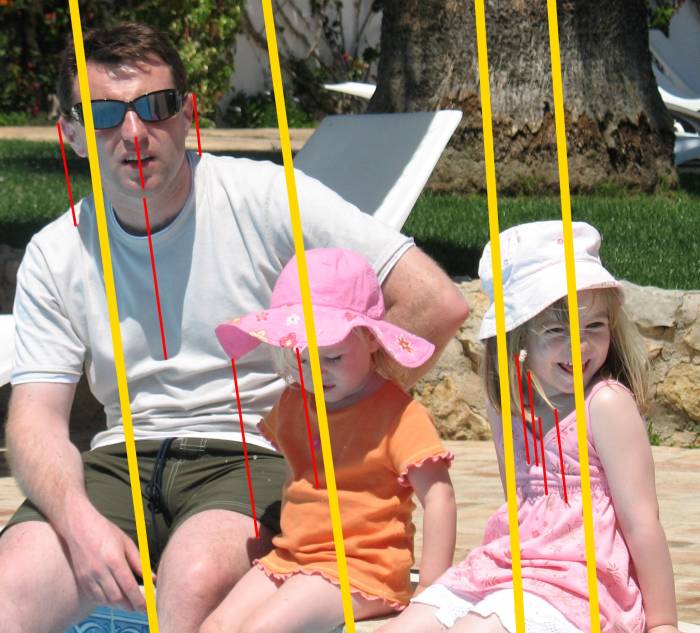
First of all we can see, that Gerry's face is hit by the sun nearly exactly from the front. This proves that the picture was indeed taken at 14:30 which means the time wasn't changed back to summer time in early spring 2007.
In the picture we have connected easily identifiable points of the shadow with their origins, such that we can see the common 2D-projection of the sun's light incidence.
We have to remark here, that the shadows at Maddie are less precise, lighter and more blurry. While on Gerry and Amelie there are a lot of precise lokations of shadows, at Maddie there are only hair's shadows which can be identified precisely.
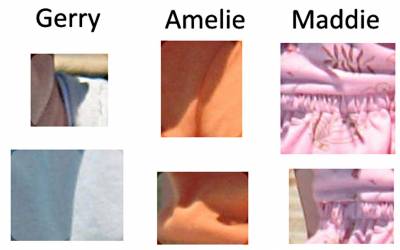 Possibly the different sharpness of shadows may be attributed to different lighting conditions, the later to be at time with a more diffuse sun.
Possibly the different sharpness of shadows may be attributed to different lighting conditions, the later to be at time with a more diffuse sun.
Obviously there is a small difference between the lines for Gerry and Amelie on the one hand and Madeleine on the other hand. But we have also to admit that the small difference is not ultimate convincing. This is as the distortion of the camera lens, which gets larger at pictures border, could be responsible for the small difference too. This but could only be examined by calculating the exact optical data of the used Canon lens.
We also may have a more close look at the bunch of shadows on Gerry's face and T-Shirt.
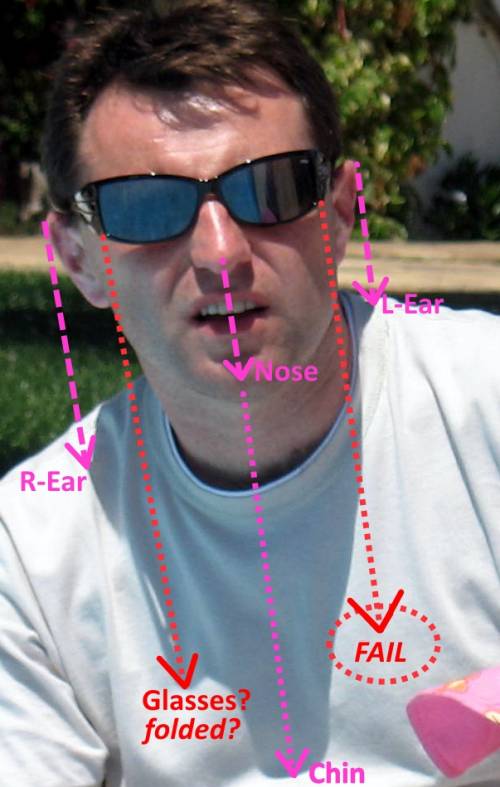
Here we have a lot of points which can clearly be connected. Disturbing is the part of the shadow left down in the picture, which on a first view may appear to be the shadow of the right sunglasses edge. But as easily can be seen this can not be the case, as then the second edge is missing (circle). Here we have at least three possibilities: (1) The shadow is produced by pure chance through the complex 3D-folding of the T-shirt only miming a sunglass shadow. (2) It could be another poorly done fake by Gerry, as he forgot to allocate the second edge too. Or (3) it is just a shadow produced by the folded sunglasses hanging at the right part of the collar of his T-shirt in the original photo.
Such questions are always difficukt to address in forensics. It stems from the complicated 3D-surfaces at arbitrary angles between sun, objects and the focal plane. We may see this here at the shadows in the face of Gerry:

From simple geometry we know, that the ratio of length L of a shadow of a rectangular orientated object N should be on a vertical plane L/N=1/tan(Zenit-angle), which gives for 14:30 o'clock a ratio of about 2.5. (Remark: for the shadow on a horizontal plane it is L/N=tan(zenit-angle)=0.4 at 14:30.) But indeed the lengt of the nose's shadows has a ratio of about 4 in the picture. This stems from the fact, that Gerry's face is tilted towards the cam like shown in the picture (with a side shot of Gerry's face taken from another photo for comparison of the correct ratio's). From this the shadows in the face (marked 1 to 4) are produced by the slightly tangential light. The difficulty in comparing different shadows and their ratio L/N of the different persons/objects in the photo now lies in the fact, that the two needed exact tilt angels (both horiziontal and vertical) are never known exactly in a 2D-projection.
At last we may do a comparison of the Azimut angle of the sun. This is a little bit more difficult as the altitude angle (height) of sun is large:
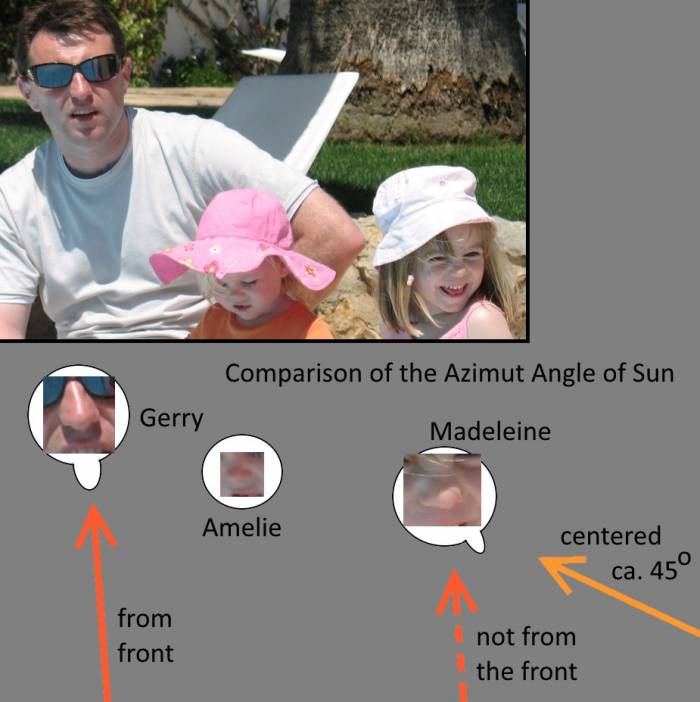 As we may see, Gerry's Nose is lightened neraly exactly from the front, a little bit from the left side (from camera view). Amelie's nose is full in shadows and cannot be used for comparison. But Madeleines Nose is partially lightened. But seemingly the nose is enlightened from much more from the right (east = earlier day time) as Gerry McCann. As with no doubt Madeleine has turned here head more to the east as Gerry did, her nose now should be enlightened in full from the other side!
As we may see, Gerry's Nose is lightened neraly exactly from the front, a little bit from the left side (from camera view). Amelie's nose is full in shadows and cannot be used for comparison. But Madeleines Nose is partially lightened. But seemingly the nose is enlightened from much more from the right (east = earlier day time) as Gerry McCann. As with no doubt Madeleine has turned here head more to the east as Gerry did, her nose now should be enlightened in full from the other side!
This indeed would be a very strong hint for a fake. The problem but here is the border line of the hat which drops a shadow on to the nose. Without a strict 3D-model at hand we cannot be 100% sure, that the borderline of the part of the hat which is reponsible for this detail is really a approximatly straight-horizontal one but arbitrarly curved. Which then could eventually just mimic such an impression.
Finally from this short-term forensics of the shadows we have to conclude:
- There is a small difference in the direction of the shadows of Gerry/Amelie and Madeleine.
- There are differences in lighting conditions of Gerry/Amelie and Madeleine.
- This may stem from a cut-and-paste fake putting Madeleine into the picture. But each of the differences are, in my opinion, to small to be taken on its own as an ultimate prove.
- The picture seemingly was taken at 14:30 as the McCann's claimed.
Detectable ARTEFACTs
Professionals use large loss-less RAW formats in picture data files. Cheap amateur cameras but always produce JPG-formatted data-files. This comes historically from the need to save expensive storage space and reduces time for transferring the picture to cheap but slow memory cards. Today this is not a technical and financial problem for cameras any more, but it is still a problem in distributing pictures via email and internet through limited bandwidths. So JPG-format is still in use, as it dramatically reduces file sizes.
The price to pay but is the loss of some picture information and the production of →some typical jpeg-artefacts like “block-coding”. When performing block-based coding several types of artifacts can appear:
- Ringing
- Contouring
- Posterizing
- Staircase noise (aliasing) along curving edges
- Blockiness in “busy” regions (macroblocking, quilting, checkerboarding)
Around sharp contrast edges we thus always get some artefacts in a JPG-picture. The same but appears when by cut-and-paste some objects are pasted into the picture. This may be visible if the the software and/or the artist doesn't smooth enough such margins. Unfortunately there is no way to ultimate decide if such artefacts are “naturally” produced by the camera software in the original picture or are stemming from a deliberate cut-and-paste-fake. We always have to hope, as a forensic specialist, that the “artist” or the picture editing software did not work perfect.
We can see such artefacts e.g. at the sunglasses (by blowing up the detail to higher resolution), where we definitely know that they are faked:

At the large contrast white reflections (which stem originally from the white T-shirt) we can see the typical jpeg-blocking-artefacts resulting from the cut-and-paste insert.
For better visibility the detail was contrast enhanced. At the insetted sunglasses absent frames those typical jpeg-artefacts are very strong and can't be missed by any expert. It proves beyond any doubt that the “Last Photo” is a deliberate fake.
We may now look at other parts for such artefacts.
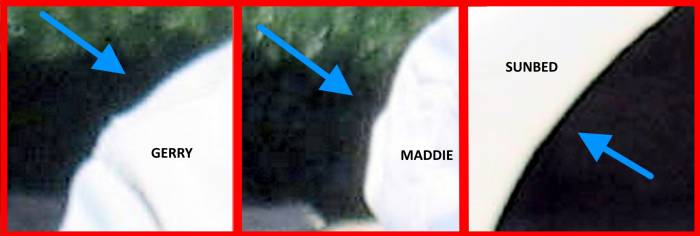
In this details-picture we have selected some black vs. white edges, which is Gerry's shoulder, Maddie's hat and the sunbed in sunlight. As we may see we have at all margins some artefacts. But at the sunbed, which is definitely not a fake, there are seemingly no large artefacts. At Gerry shoulder there are also slightly visible artefacts (so called ringing, which is a kind of double ghost-line), but at Maddie's hat they are the strongest.
Again me may conclude, that Maddie was cut-and-pasted in. But, also again, those artefacts are not that strong that they can be taken as an ultimate prove. It is just an inconclusive hint.
The next evidence we can analyse is the fact, that at least parts of this picture were used by Gerry for an PR-Photo of Madeleine (first anniversary on 03-May-2008).
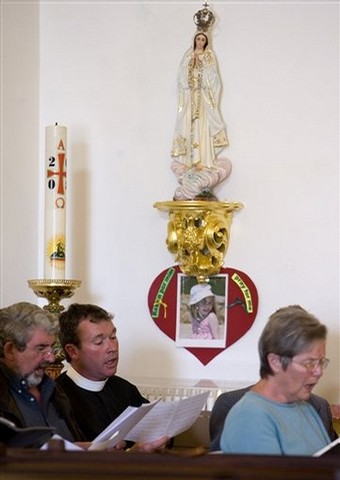 We may now exactly put in this photo into the “last photo” for comparison:
We may now exactly put in this photo into the “last photo” for comparison:
 What we can see at once is, that at least one of the two photos must be a fake. A full frame was provided by Gerry's blog:
What we can see at once is, that at least one of the two photos must be a fake. A full frame was provided by Gerry's blog:
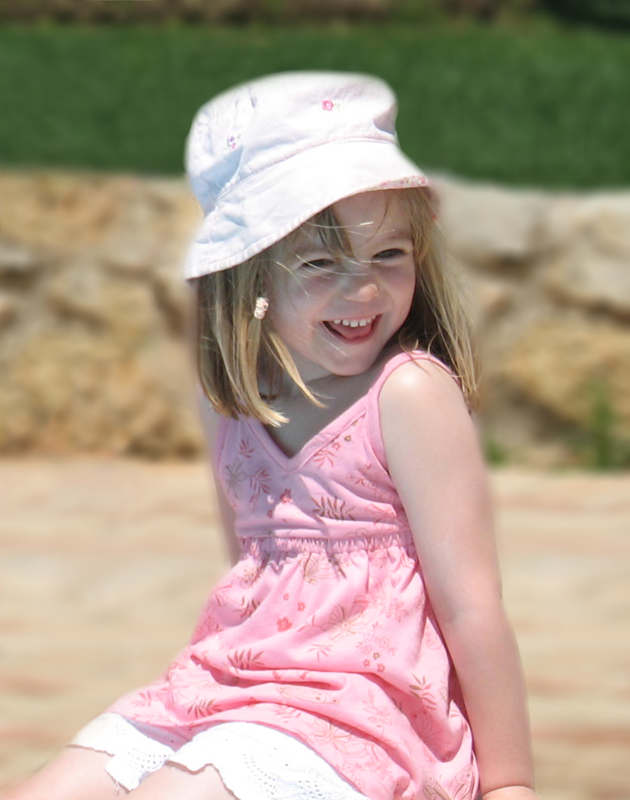 On a first view this seemingly proves that Maddie was faked in the "Last Photo". But this cannot be coercively concluded. As it is just a PR-Photo (and thus not a photo given for alleged evidence to the public) it may be cut out from the “Last Photo” and then altered for beauty reasons.
On a first view this seemingly proves that Maddie was faked in the "Last Photo". But this cannot be coercively concluded. As it is just a PR-Photo (and thus not a photo given for alleged evidence to the public) it may be cut out from the “Last Photo” and then altered for beauty reasons.
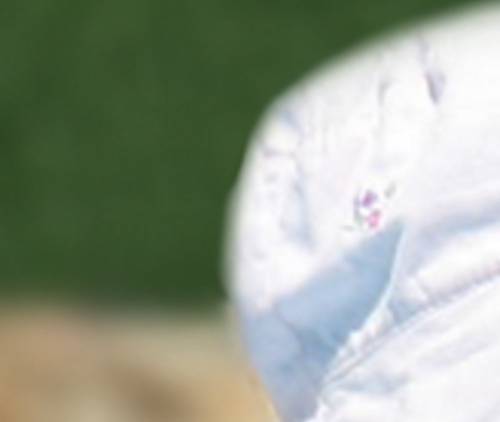 Obviously in this picture the background was heavely blured to enhance the poor amateur photo to look more professional. This would not be unethical, its just the thing every advertiser does and for which photoshop is regularly used.
Obviously in this picture the background was heavely blured to enhance the poor amateur photo to look more professional. This would not be unethical, its just the thing every advertiser does and for which photoshop is regularly used.
On the other side in this PR-Photo, which has PNG-format, there are no margins to be seen. Another seemingly problem is the resolution - If we look for example at Amelies and at Maddies hair's:
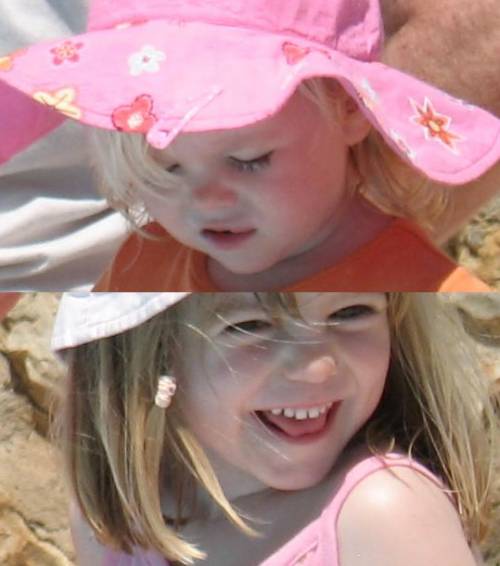 we may see that Maddies hair has a better resolution as the hairs of Amelie, although definitely both girls are photographed from practically the same distance. In addition it is the fact, that camera lenses usually lose some resolution at the pictures border, which is in contrast to the fact that Amelie is close to the center and not Madeleine. The same is true for other parts of the two girls: e.g. the lips, the nose and the borders and fissures of the shirts are seemingly sharper for Maddie. This may be interpreted as a hint for two different picture sources with different resolutions.
we may see that Maddies hair has a better resolution as the hairs of Amelie, although definitely both girls are photographed from practically the same distance. In addition it is the fact, that camera lenses usually lose some resolution at the pictures border, which is in contrast to the fact that Amelie is close to the center and not Madeleine. The same is true for other parts of the two girls: e.g. the lips, the nose and the borders and fissures of the shirts are seemingly sharper for Maddie. This may be interpreted as a hint for two different picture sources with different resolutions.
But what does it tell us? There are different possibilities:
- The unaltered PR Photo was the original source used to fake Maddie into the alleged "Last Photo".
- The PR photo was cut out from the alleged (but at least partially faked) “Last Photo” and then just “beautified”.
- Also thinkable: not only Maddie was cut-and-paste faked into the “Last Photo”.
For the last possibility (3) there are also some hints in the “Last photo”:
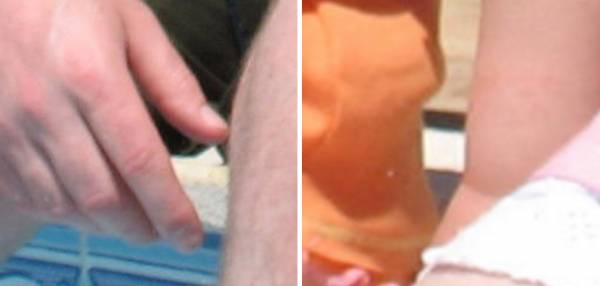 This is seemingly no shadows where Gerry is sitting (left) and a black line which can only be seen between Amelie and Maddie (right) which is suspicious. In the extreme we could understand that all of the group were put into the picture, which but sounds somehow implausible (why should have he photograph an empty scene?). More plausible but would be the supposition that not Maddie, but Gerry and Amelie were faked in. But indeed the shadows ratio for horizontal planes was 0.4 and thus may disappear at Gerry's trousers. And the black object behind Amelie may be just e.g. a drainage of the pool.
This is seemingly no shadows where Gerry is sitting (left) and a black line which can only be seen between Amelie and Maddie (right) which is suspicious. In the extreme we could understand that all of the group were put into the picture, which but sounds somehow implausible (why should have he photograph an empty scene?). More plausible but would be the supposition that not Maddie, but Gerry and Amelie were faked in. But indeed the shadows ratio for horizontal planes was 0.4 and thus may disappear at Gerry's trousers. And the black object behind Amelie may be just e.g. a drainage of the pool.
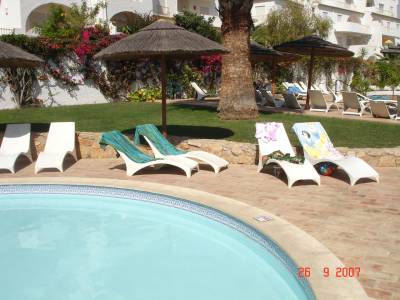
The last picture I found was made in Spt. 2007 (source: gerrymccannblogs). It clearly shows that there was no object belonging to the pool behind Amelie. This of course seemingly is an indication of Amelie also deliberately put into the picture. Then seemingly Gerry was the only one person in the original picture taken by Kate. But we don't know for sure, if in May there was some removeable miracolous object behind Amelie.
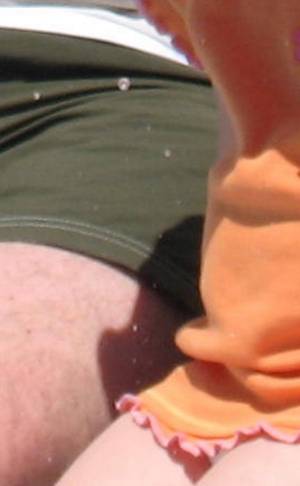
But what speaks against a cut-and-paste of Amelie are those flying drops and also the shadow falling on Gerry. Although such things are fakeable with Photoshop software it needs some photographic knowledge to do so. If we compare this but to the two stupid failures in the fake of the sunglasses Gerry did, we may assume that it is implausible that he did a such well fake with Amelie now.

In comparison to the shadow of Amelie falling on Gerry we finally must have a look at the similiar situation of Madeleine and Amelie: There is indeed no shadow from Maddie which falls on Amelie.

What but is a seemingly 100%-proof for Amelie being in the original picture is the reflection in the sunglasses. It seemingly shows the tip of Amelies hat. It is not thinkable that this tip would be a “fake in a failed fake”.
Finally from this short-term forensics of the detectable artefacts we have to conclude:
- There are some undeniable hints for the assumption that Madeleine but was faked into the picture.
- But there are no ultimate proofs for this, as every of the artefacts may be explained also harmlessly e.g. by pure chance and/or poor JPG-quality pictures.
Forensic Summary and Conclusions
Summary:
Regarding the so called Last Photo picture forensics show:
The EXIF Data of the last Photo documents the fact, that it was taken on 3rd May but then altered using Adobe Photoshop on 24th May 2007:
Create Date 2007:05:24 17:41:20+01:00 Creator Tool Adobe Photoshop CS Windows.
From this it is not a question if or if not it was altered after it was taken on 3rd May. The only discussable question therefore is WHAT was altered in the Photo?
From forensics we come to the conclusion: The picture in general is proven to be a fake. This conclusion stems independently from two 100%-proofs of the faked-in sunglasses:
- the false reflections in the sunglasses and
- the failing to provide frames at the ears.
- the EXIF entry independently proves that it was altered
There are also some artefacts which may hint, but very inconclusive, to Madeleine been faked in by cut-and-paste into the picture. From today's quality of Photoshop software, we cannot decide definitely if, or if not, Maddie was pasted into the photo. I would tend to say she was in the original photo. My believe stems from the fact, that the fake of sunglasses includes two separate stupid photoshop-beginners failures. From this it is not likely that in other fakes he would have worked so much better and professional.
From this it follows with great certainty that Maddie was still alive at 14:30 on 3rd May 2007.
What but is out of any question is that Gerry faked the sunglasses in the “last photo”.
Of course the question arises why Gerry had to do so. The only probable answer is that he had reason not to show his eyes like they really were on 3rd of May. It is obvious that the reason to hide his eyes by a deliberate fake of evidence can not been attributed just to beauty reasons. Seemingly his (left) eye was in bad condition. Sow where did this come from? Surely not from just simple reasons (like e.g. illness or accident) which could be told to anybody in the circumstances at the time.
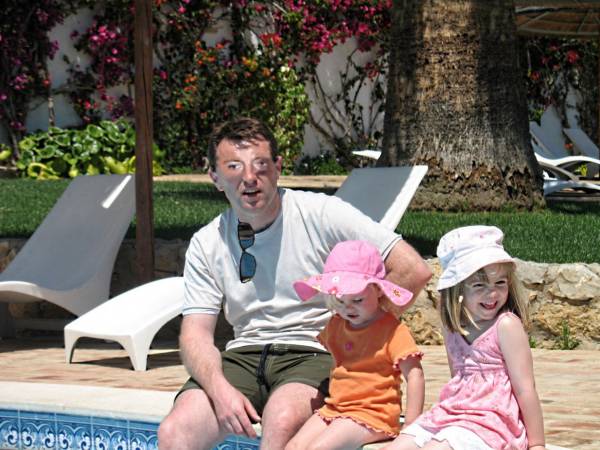
The acceptable reason for Gerry's to hide his bad:
Obviously the bad eye had to be attributed to a typical injury from a slap into his face. Which may be easily attributed to insanely jealous Kate after she was debased by Gerry's open flirt with the busty waitress on evening/night 1st/2nd May. See the description of the incident on 1st May at Oddities sample 8. This heavy incident was known already to the police and it was out of question to Gerry and Kate to concede this utter quarrel. As it is on hand that such heavily stressed mothers, confronted on one side with adultery and possible divorce and on the other side with intense childcare duties, with the eldest daughter being known as →sometimes intractable, are typical offenders in such family tragedies. All the evidence, especially regarding a sedation of the kids, would have got much more forensic weight.
From this we can assume that the “story of the last photo” ran as follows: After the event on evening 3rd May, there was a high demand for a last photo from forensics and also for the search for Maddie. But indeed Gerry could not provide any. Why? Obviously as all photos from the 2nd and 3rd of May showed him either with a bad eye or there were indeed no photos taken as the parents were not in the mood to do so (as in (divorce) stress and anger). Obviously the only authentic photo (with the correct EXIF date of 3rd May) he had was the one which was taken by Kate on the 3rd May at 14:30 o'clock (EXIF data shows from a shrouded distance of 30 feet using tele optics). But with his bad eye to be seen, as seemingly spiteful Kate took it just for this reason.
But things changed after 16th of May as at Leicestershire Police UK the Payne-allegations came in. As the question of the alleged nonexistence of any photos of 3rd May (day and evening) had already got reason for suspicion, seemingly Downing Street spokesman Clarence Eden Mitchell urged him to give any available photo taken on 3rd May to the public. So three weeks after the event Gerry decided to take this only one he had but necessarily he had to fake the sunglasses onto his at this time still bad eye. What he but seemingly did not know is that the EXIF header would also store the second date of alteration (if he knew he would have taken a special software for changing EXIF data too, this was the third photoshop-beginners failure.).

